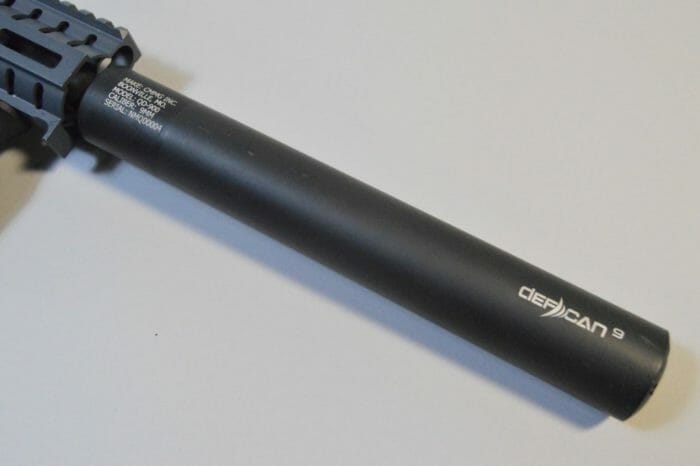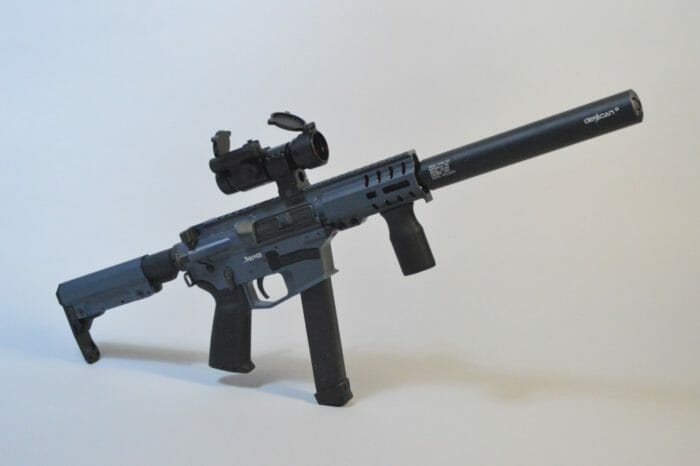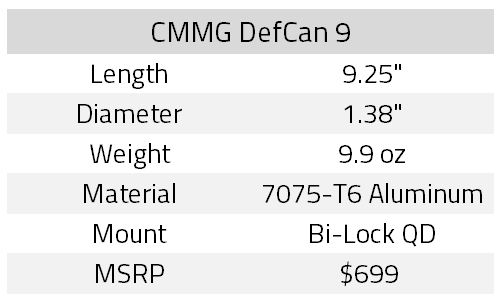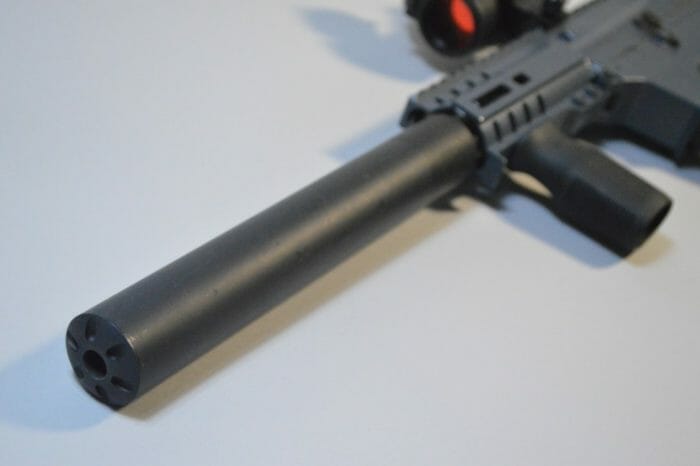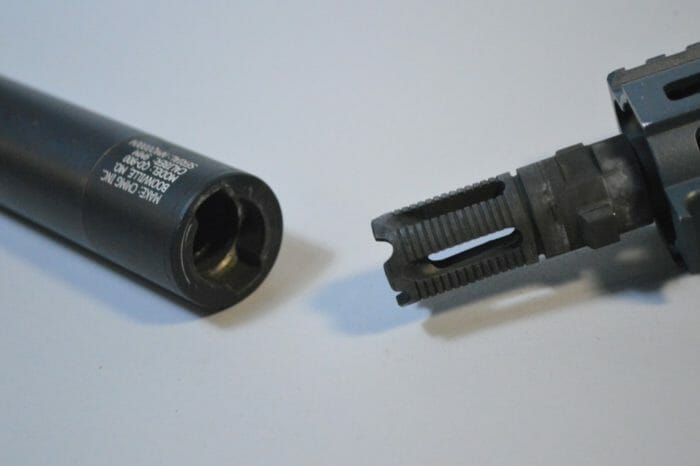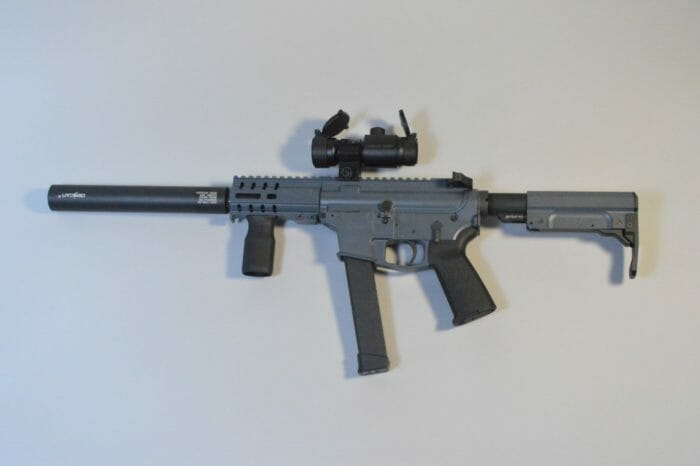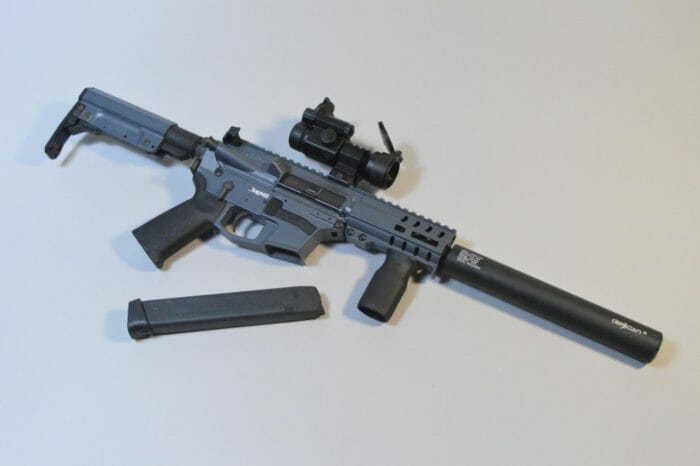Silencer Shop Authority: CMMG DefCan 9 Review
I’m not sure if you’ve heard, but suppressors are pretty popular these days. Long gone are the days when tiny, dedicated manufacturers were the only players in the game. Today, even Ruger has a line of silencers and Smith & Wesson recently jumped into the game via its Gemtech acquisition.
Last week, another traditional firearm manufacturer joined the fray when CMMG introduced its DefCan line of suppressors. Announced alongside the company’s also-new Banshee carbine lineup, the DefCan series is a well-rounded collection of silencers with options ranging from .22 LR to .308. Our friends at Silencer Shop recently sent over a couple of the Banshees along with the DefCans that go with them. Today, we’ll take a close look at the lightweight 9mm DefCan 9.
Size & Weight
There’s no doubt that the CMMG DefCan 9 is a true subgun suppressor. Sure, its 1.38” outer diameter is in line with most pistol silencers, but the DefCan’s 9.25” length is a good bit longer than your average pistol can. This bucks the industry trend toward super-short suppressors for pistol-caliber carbines. Surprisingly though, on a short 9mm carbine like CMMG’s Banshee, the inch or so of extra length over a compact suppressor was (at least in my opinion) barely noticeable. If it helps to squeeze out additional sound reduction – and it does – it’s a worthwhile tradeoff by my standards.
Though the CMMG DefCan is large, it isn’t all that heavy. At just 9.9 ounces according to my postal scale, it’s in a much lower weight class than its silhouette would suggest. Truly, on the end of CMMG’s new Banshee MkGs 9mm, the DefCan feels like a feather and I strongly believe that the can’s lightweight is why I don’t find the length objectionable.
Materials & Design
The entirety of the DefCan is constructed of 7075 aluminum alloy with a T6 hard coat anodized finish. This keeps the can relatively light, and 7075 is durable enough to handle 9mm pressures – including full-auto use – without issue. It does mean that your options for cleaning the suppressor are limited, but the sealed tube is going to be a much more significant limiting factor here than the can’s build material.
Inside the DefCan are seven M-style baffles. Each baffle’s bore aperture sports a squared port for gas jetting, which improves performance by directing gas particles laterally inside the suppressor. For whatever reason, I was concerned that CMMG might opt for a monocore design with this silencer. I’m not exactly sure why I felt that way, but it does seem to be a common route taken by suppression newcomers. Fortunately, they chose a proven, better design in conical M-baffles that I feel paid off. I’ll have more on that in just a moment.
I’m sure some of you cringed when you read that the CMMG DefCan 9 is a sealed suppressor. Yes, that means it isn’t user-serviceable, and I’m torn on this matter. There’s no doubt that I wouldn’t use cast lead bullets with this silencer. They’re notorious for leaving behind lead buildup that requires thorough cleaning to remove. However, I’m also not all that troubled by CMMG’s decision here. I’ve owned my SilencerCo Octane 45 for over four years now. In that time, I’ve cleaned it exactly once, and the only reason I did so was to remove grime left behind by .22 LR ammunition, not centerfire pistol rounds. Since that cleaning, I’ve ceased using the Octane with rimfire calibers and have found that it frankly doesn’t need much (any) maintenance. Occasionally adding a little grease to the piston is enough to keep it running and sounding fantastic. Because of that, I’m just not worried about the CMMG DefCan 9.
It was tough for me not to say this earlier in the review, but I really, really love the DefCan’s Bi-Lock mounting system. If you think this system looks familiar, you’d be correct. It’s the same design used throughout the years by silencer giant, Gemtech. There’s a bit of a story behind the Bi-Lock and its appearance on a non-Gemtech suppressor, but I’m not going to delve into that here. The important part is that CMMG worked with the system’s original designer to bring it to their new suppressors, and it works fantastically well. Bi-Lock works just like the 3-lug system made famous by the MP5 – just slide the can over the lugs on the muzzle device, firmly press it down to compress the internal spring, and turn it 90-degrees to lock it into place. The meaty lugs on the included Bi-Lock flash hider are significantly heartier than those found on 3-lug barrels and mounts.
Range Report
The CMMG DefCan 9 sounded absolutely excellent on the Banshee. It seemed to be a smidge louder at my ear than the DefCan 45 (that article is coming soon), and it didn’t quite reach the subjective performance levels of my SilencerCo Octane 45 on my MP5, but it still sounded great. The main differentiator between the DefCan 9 and these .45 ACP alternatives seemed to be pitch or tone and not necessarily outright sound levels. Without a meter to get true measurements, it’s impossible to definitively say that this was truly the case. Regardless, my ears weren’t ringing in the slightest, and I could have used the pairing all day without consequence.
What I can positively say is that the DefCan benefited from the Banshee’s Radial Delayed Blowback system. I don’t want to spend too much time on this here, as a dedicated Banshee MkGs review is on the way, but I can’t ignore the facts when discussing the DefCan. It’s amazing to hear the difference between a delayed blowback action and a standard straight blowback system. Thanks to CMMG’s engineering, the DefCan-equipped Banshee MkGs was quieter at-ear than the integrally-suppressed Brown Recluse from Spike’s Tactical. That’s remarkable.
As far as first-round pop (FRP) is concerned, the DefCan 9 put up a good, but not perfect, showing. The first round through the oxygen-filled, cold DefCan was noticeably louder than subsequent shots. My experience suggests that the range footage in the video shared above exaggerates the effect. The FRP wasn’t unpleasant or overwhelming. It was, just, there.
All in all, I found the CMMG DefCan 9 to be very impressive, particularly when you consider that it is one of CMMG’s first attempts at a suppressor. If there’s one area I found somewhat disappointing, it was the point of impact (POI) shift I experienced with the can mounted to the Banshee. At 25 yards, my suppressed groups were 2” left and down from my unsuppressed control groups. That translates to around 8 minutes of arc (MOA) at 100 yards (an ambitious distance for 9mm subsonic ammunition, no doubt). The change was substantial enough that I checked the can for baffle/end cap damage after the string. Everything looked fine to my eyes, and the results were repeatable. They were also further validated by a similar experience with the CMMG DefCan 45. This one still has me perplexed.
Conclusion
I doubt many readers have gotten this far in the review and thought to themselves, “wow, the CMMG DefCan 9 is truly revolutionary.” It’s true, there’s nothing here that hasn’t been seen before in some capacity. M-baffles aren’t new, 7075 aluminum alloy is common, and QD subgun cans aren’t in their infancy. Yet having said all of that, there’s still reason to like the DefCan 9.
While I would have loved to have seen a more durable choice than 7075-T6, the DefCan is extremely light for a suppressor of its stature. The industry has generally moved toward shorter suppressors, but I’ve found them to be somewhat disappointing from a performance perspective, and I would gladly take another inch or two as long as a massive weight penalty isn’t included. With the DefCan, it isn’t.
If you’re in the market for a lightweight, subgun-optimized suppressor, Silencer Shop has the DefCan 9 listed for just under MSRP at $679. Pricing may vary somewhat between Powered By Silencer Shop dealers.
An information security professional by day and gun blogger by night, Nathan started his firearms journey at 16 years old as a collector of C&R rifles. These days, you’re likely to find him shooting something a bit more modern – and usually equipped with a suppressor – but his passion for firearms with military heritage has never waned. Over the last five years, Nathan has written about a variety of firearms topics, including Second Amendment politics and gun and gear reviews. When he isn’t shooting or writing, Nathan nerds out over computers, 3D printing, and Star Wars.

